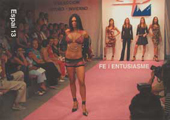- Exhibition program
- Cycle: Angle of vision: 143º
- Author
- Antonio Ortega
- Dates
- —
- Curated by
- Montse Badia
The work of Antonio Ortega (Sant Celoni, 1968) deals with social behaviour and social dynamics. He often creates "records", employing a strategy similar to that of a fable, with easily recognisable reference points to exemplify or illustrate different situations. For instance, in Record of frailty (1966) he forced a plant to grow inside a long cardboard tube so that when the tube was removed the plant withered away; in Record of sponsorship (1999-2000) he spent the production budget for his exhibition in Barcelona on sponsoring an English piglet called Lucy, providing it with care and attention, food and veterinary services for a year; in Record of goodness (1999) he made himself sick, kept the vomit in a container in the garden of his house in London and let the birds feed on it. As David G. Torres has pointed out, "They are records in which the unusual is a millimetre away from the futile. It is in this millimetre that his work lies… The document, anodyne in its appearance and simply a portrait of an experiment carried out by Antonio Ortega, has the ability to develop intensely at the level of meaning." In these three instances, the behaviour, reactions and roles of plants and animals become portraits or projections of our own behaviour in accepting, adapting or submitting to the prejudices implicit in acts of generosity.
From a naïve position devoid of any cynicism, Ortega observes with a permanent sense of perplexity and doubt the mechanisms that define the dynamics of artistic production and its purpose in society. In Antonio Ortega and the contestants (2002), for example, he transformed what was to have been a one-man exhibition in The Showroom in London into a group exhibition and invited five recent graduates from the Faculty of Fine Arts in Barcelona to take part in it with him. The aim was to try and demonstrate the dynamics of production in art, by imitating the promotional strategies employed in other areas of pop culture, while at the same time exploring the idea of authorship and the hierarchical and competitive nature of the art world.
Faith and enthusiasm is based on an idea he has been pondering for some time: the fact that only success releases the artist from the appearance of ingenuousness. Ortega explained this at a talk he gave in March 2002 in CaixaForum, Barcelona: "I think there is nothing more pathetic than a visual artist - or a singer or an actor - who has not been successful, because only a taste of success can neutralise the feeling of ingenuousness of an artist devoted to his career. If you still have doubts about this, you can join me in the following exercise. Think of a major artist and imagine that he only shows his work to his elderly parents. On Sundays he goes with his family to have lunch at his parents' home and after coffee he shows them his latest works… I don't know about you, but when I was writing this I was imagining a dignified Joseph Beuys carefully collecting on a tray the congealed lumps of fat stuck to the walls of his parents' dining room. This is why I accept my naïve status."
Faith and enthusiasm takes a look the current media scene, which creates personalities who come to exemplify stereotyped values. In Spain, television has created a new genre, a cross between the reality show and the soap opera, in which the lives and doings of these personalities can be followed, dissected and criticised, for they automatically place the audience in a superior position. Those who populate the current media scene are not (famous) public figures on account of their professional accomplishments but people who have turned the details of their private lives into a profession. Achieving fame at any price and maintaining it at any price is one of their main characteristics. Faith and enthusiasm concerns one such artiste, Yola Berrocal, the epitome of the fabrication of a celebrity, described by Ortega as "the real muse of enthusiasm" convinced of her own artistic talents. Ortega shares a faith with Berrocal - in their work and their possibilities of success - that eliminates any idea of cynicism.
In Faith and enthusiasm, he takes a detailed look at this mass media universe. His installation consists of an Fundraising Office for obtain money for a wax figure of Yola Berrocal. In our media-mad world, having one's figure in a wax museum is the ultimate status symbol. It was only a short while ago, for example, that Madonna achieved this recognition. The office created by Antonio Ortega is run by art teacher and freelance curator David Armengol, assisted by two final-year art students, Lucía Moreno and Eva Noguera. The work of this team is to establish contacts, submit proposals and try to obtain financing in the form of sponsorship, in order to attain the goal of creating a wax figure of Yola Berrocal.
With a slight shift in aim and context, the office replicates exactly the production and communication structures of the world of contemporary art. Ortega uses easily identifiable references that provide us with the necessary distance - a plant, Lucy the piglet, the birds in his London garden, gags by Faemino and Cansado, and Yola Berrocal herself - in order to set up situations that relate directly to us and to our experiences. The sense of humour with which we confront stories that seem to have little to do with our lives can turn to deep embarrassment when we realise that the tales that Antonio Ortega tells are actually about us. It is only from a naïve position that the artist is able to really question our own reality and the values we consider to be absolute.
Montse Badia
January 2004








